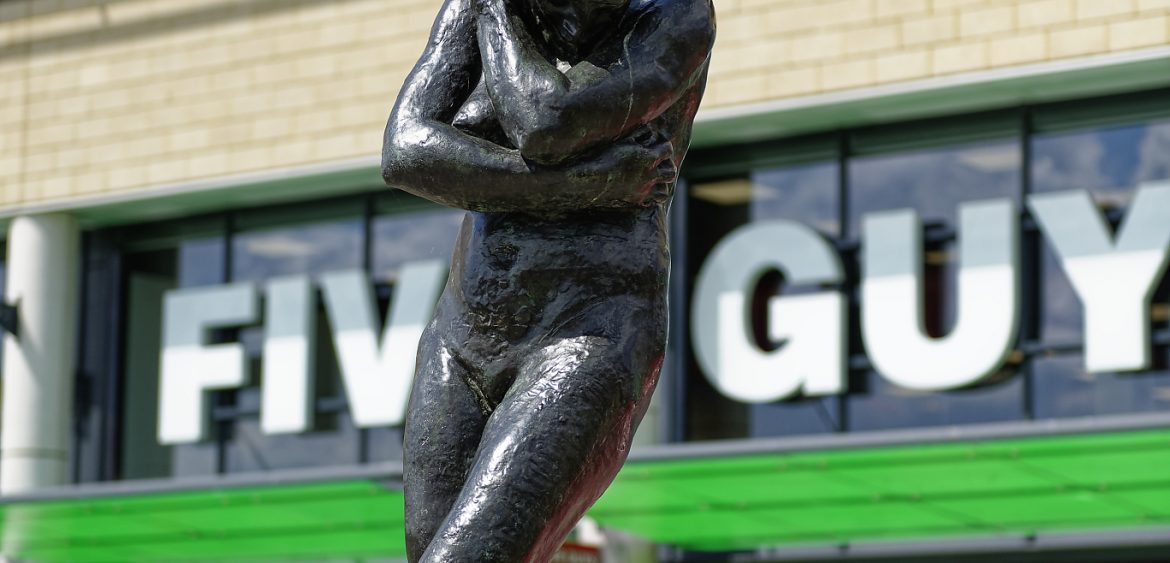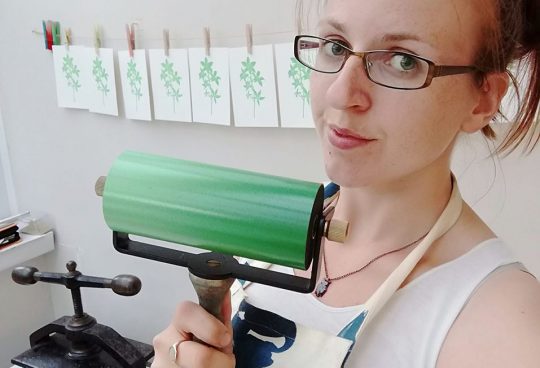Bronze cast. Modelled
1882 Height 170 cm – Water Gardens, Town Centre
Eve was purchased on behalf of the Development Corporation and donated to the Trust by Ben Hyde Harvey. Ben Hyde Harvey was General Manager of the Harlow Development Corporation and a Trustee (The Harvey Center was named after him). Sir Philip Hendy used his influence to acquire the work from the Rodin Museum in Paris for £2,360 in 1959. The cast was one of a limited edition. Originally sited on Broad Walk with the intention of it being sited in the Water Gardens once complete. The plinth or base remained in Broard Walk after Eve’s move to the Water Gardens in 1963. Trigon by Lyn Chadwick is now sited on this plinth. In 1987 at attempt was made to steal Eve by wrapping a chain around its base, whilst the sculpture was not stolen it was damaged and was taken away for repair. There was plenty of discussion between the Trust and the Council at the time regarding the state of the water gardens. The Water Gardens were in a state of disrepair. Works in the collection rarely get vandalised, however if an area becomes run down and not maintained/cleaned etc it attracts vandals and the sculptures suffer. The only other times works are vulnerable is when they are first sited or moved to a different location. Stolen works are usually stolen to order, or for practical jokes, or for their material value. Eve was eventually returned to the water gardens in 1990 once the Council had undergone refurbishment of the area. Its current base coincided with its return, and the work has been strengthened with a steel rod running through the figure and into the ground. Eve, a companion to Adam, was to be part of the sculptural project, The Gates of Hell, which remained unfinished at Rodin’s death.
In 2013 Eve was loaned to the Henry Moore Foundation at Perry Green for the exhibition Moore Rodin and a Moore work was substituted in the Water Gardens. Eve was recleaned before her return. See Newsletter number 17 May 2013.
The Gates of Hell
Rodin received a commission from the Directorate of Fine Arts for a monumental door which was to be decorated with low reliefs inspired by The Divine Comedy of Dante. This door was intended for the planned Museum of Decorative Arts in Paris to be built on the site of the Cour des Comptes, demolished in 1871 (this site is now occupied by the Musée d’Orsay). The subject was probably suggested by Rodin for it is known that he admired Dante and used to keep a copy of his book in his pocket. He started to work feverishly in a studio specially allocated to him for the purpose at the Dépôt des Marbres in Rue de l’Université.
Rodin ignored two thirds of the poem by Dante to concentrate on its darkest side, the part about Hell. The first year was primarily devoted to sketches which followed the text of the poem closely, but once he started modelling, he only retained a few identifiable characters, such as Paolo and Francesca, Ugolino and his Children, The Shades, and The Thinker, a portrayal of Dante himself, among a host of figures in different sizes. These figures were made independently of one another. They were tried out on a wooden frame in 1882, and then set aside. By 1884, Rodin felt confident enough about his project to make an estimate for the bronze casting, which was ordered on 20 August 1885. Although the model, probably mounted at the end of 1885 or beginning of 1886 did not satisfy him, a few privileged people were allowed to see it. By this time the Shades were in place and the Paolo and Francesca group (later to be called The Kiss) was still set in the centre of the left wing. However, the Paolo and Francesca group was removed shortly afterwards for Rodin realized that the state of pure happiness this sculpture portrayed did not really fit in with the rest of the composition.
Rodin was expected to present The Gates of Hell at the Universal Exhibition of 1889. Even though he could not make up his mind, he allowed a greater number of visitors to see the work, including Claude Monet who was “amazed” by what he discovered in the studio. By about 1890. After this date, Rodin was too busy working on a number of other important commissions to be able to devote much time to it. In fact, it is hardly mentioned at all after 1889.
The Gates of Hell, the first major commission received by Rodin, even though it was never delivered, can be looked upon as a summary of his entire life. It accompanied him through all the years of his career as a sculptor, and reflects his main centres of interest, his admiration for Gothic and Italian Renaissance art, for Dante and Baudelaire. Above all, it is a supreme demonstration of the expressive powers he gave to the human body. Rodin had in fact modelled bodies by the hundreds for the Gate, and very soon some of them became works in their own right, including The Kiss, The Thinker, and of course Eve.





Eve at Hoglands 


Rodin’s Eve – 2015 Photo: Jon Clempner 
Rodin’s Eve – 2019. Photo: Jon Clempner


1 Comments: